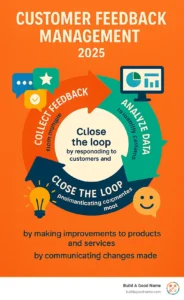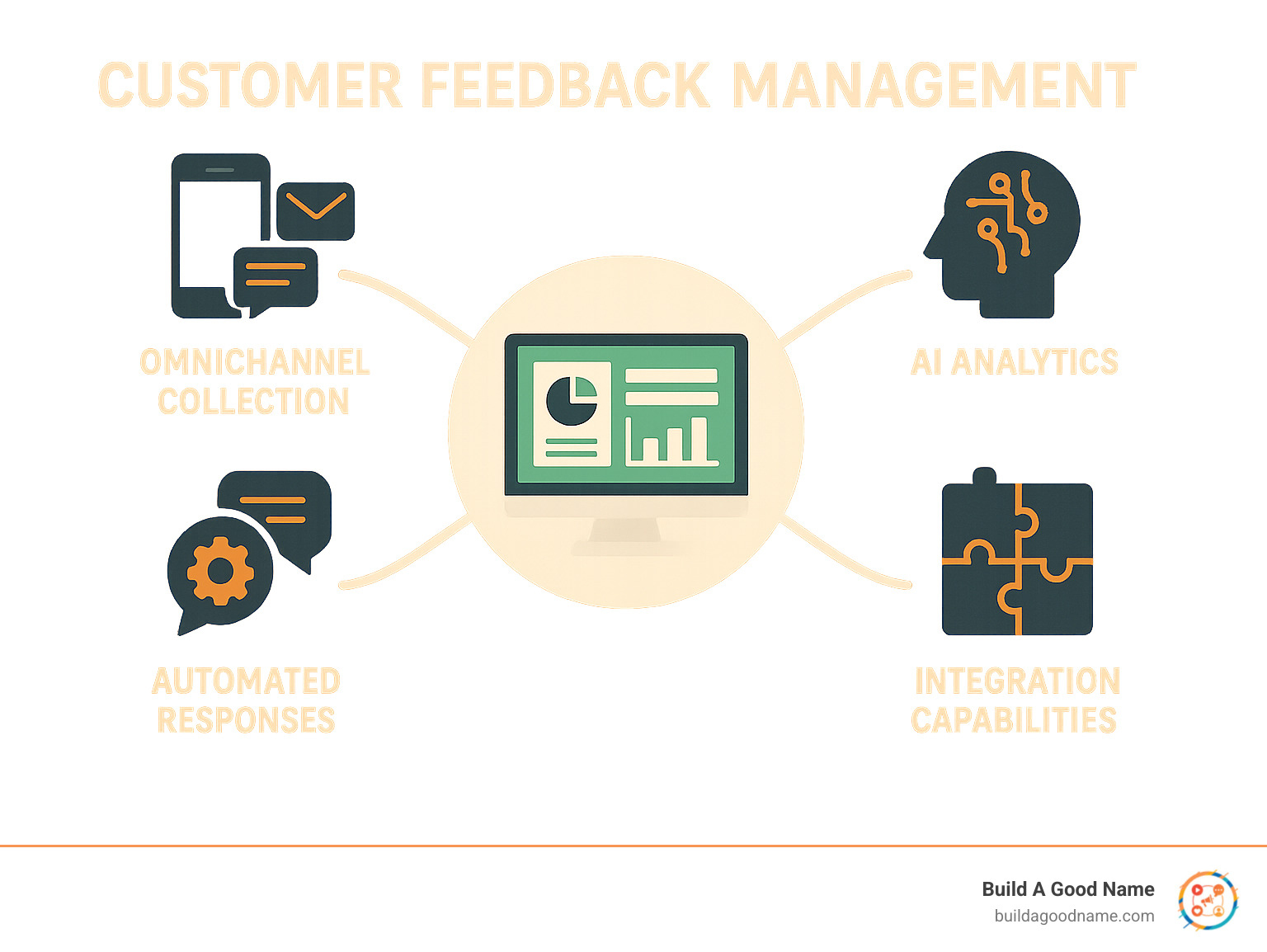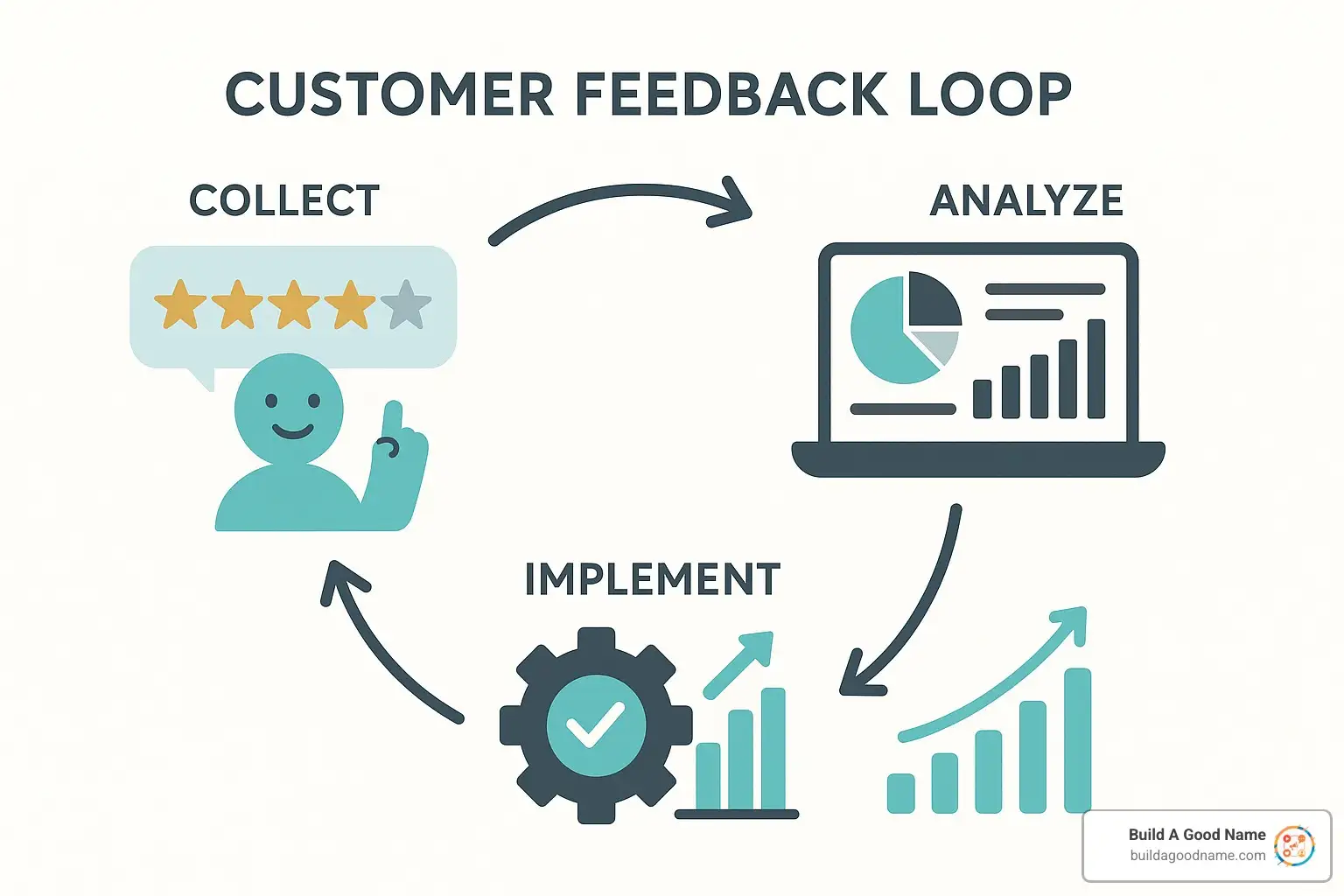Why Customer Feedback Management is Your Business’s Lifeline
Customer feedback management is the systematic process of collecting, analyzing, and acting on customer opinions to improve your business. It’s not just about gathering reviews—it’s about turning those insights into real improvements that drive growth.
Here’s what effective customer feedback management includes:
- Collecting feedback from multiple channels (reviews, surveys, social media, emails)
- Analyzing patterns to identify what customers really want
- Taking action on insights to improve products and services
- Closing the loop by responding to customers and showing you care
- Monitoring results to ensure changes are working
As Bill Gates once said, “Your most unhappy customers are your greatest source of learning.” Yet research shows that 56% of dissatisfied customers never voice their concerns—they simply leave. Meanwhile, businesses that actively listen to feedback grow 41% faster than competitors.
For local business owners, this isn’t just theory. When over half of Americans read reviews before making a purchase, your feedback management directly impacts your bottom line. Every unaddressed complaint is a missed opportunity. Every positive review you don’t leverage is potential marketing left on the table.
The good news? You don’t need a massive budget or complex systems to start. You just need the right process.

What is Customer Feedback Management (and Why It’s Your Secret Weapon)?
Picture this: You’re running a busy restaurant, and a customer quietly slips out after waiting too long for their meal. They never complain, never ask for a manager—they just leave. And worse? They tell their friends about the experience online.
This is exactly why customer feedback management exists. It’s your systematic process for gathering, analyzing, and acting on what customers really think about your business. Think of it as building a bridge between what you think customers want and what they actually need.
Customer feedback management isn’t just about collecting reviews (though that’s part of it). It’s about creating a complete listening system that transforms customer voices into real business improvements. You’re gathering feedback from every touchpoint, analyzing insights to spot patterns, and most importantly, acting on the data to make meaningful changes.
Here’s what makes this your secret weapon: while your competitors are guessing what customers want, you’re getting direct intel from the source. You’re not just fixing problems—you’re building a competitive advantage through deeper customer understanding.
The business impact is nothing short of remarkable. Improved products and services happen naturally when you know exactly what customers love and hate. Increased customer loyalty follows when people see you actually listen to their concerns. Reduced customer churn becomes possible because you’re addressing issues before customers walk away.
The numbers back this up beautifully. Companies that focus on customer experience see an 80% increase in revenue. When customers feel heard and see their feedback implemented, they’re 2.4 times more likely to stick with your brand. That’s not just good customer service—that’s smart business.
And here’s the kicker: over half of Americans read reviews before making a purchase. Your feedback management directly impacts your sales funnel. Every review, comment, and survey response becomes a potential catalyst for business growth.
For local businesses, this hits even closer to home. Your reputation spreads through your community faster than ever through online reviews and social media. Effective customer feedback management helps you stay ahead of issues and build the kind of reputation that drives genuine word-of-mouth marketing.
The best part? You don’t need a massive corporate budget to make this work. You just need the right approach and tools to turn customer voices into your greatest business asset.
More info about Online Reviews and Reputation Management
The 5-Step Customer Feedback Management Process
Step 1: How to Collect Feedback for Effective Customer Feedback Management
Think of feedback collection as casting a wide net in a pond full of insights. The key is knowing which waters matter most. You’ll work with two kinds of input: solicited feedback you ask for (surveys, review requests) and unsolicited feedback that appears on its own (social posts, organic reviews). Within those camps you’ll see structured data like star ratings and unstructured comments that need deeper reading.
Prioritize the channels your customers already use:
- Online reviews
- Short, targeted surveys
- Social media comments and DMs
- Email replies and live-chat transcripts
Track three metrics: NPS, CSAT, and CES. Research shows 65.75 % of users only leave feedback when prompted in-app, so make it quick and convenient. Ask right after key interactions and keep surveys under three minutes to maximise response rates.
More info about how to Generate More Google Reviews
Research on avoiding biased survey design
Step 2: Analyzing Feedback to Find Gold
Raw feedback is valuable only after it’s refined. Centralize everything in one dashboard, then use categorization, tagging, and sentiment analysis to spot trends. Modern AI tools now do in minutes what once took weeks, automatically surfacing recurring issues or emerging praise.
Next, look for patterns over time: Are delivery complaints spiking? Is praise for a new feature climbing? Pair those patterns with root-cause thinking so you fix problems at their source, not just the symptoms.
More info about AI for Business Reviews
Step 3: Prioritizing and Taking Action
Insights are useless until they drive change. Use an Impact vs. Effort grid to identify quick wins, and a simple Urgent vs. Important filter to avoid distractions. Then create an action plan that names an owner, deadline, and success metric. Typical actions include product tweaks, service-process edits, or clearer communication.
Step 4: Closing the Feedback Loop
Always tell customers what you did with their input. Personalise replies to reviews, email survey respondents with updates, and share bigger changes publicly on social channels. This final step turns critics into advocates and shows the entire community that you genuinely listen.
More info about the Best Responses to Google Reviews
More info about Sharing Google Reviews on Social Media
Step 5: Choosing the Right Tools for Your Customer Feedback Management Strategy
Look for software that:
- Collects feedback from every major channel
- Shows it in a centralised dashboard
- Uses AI to categorise, summarise, and suggest responses
- Integrates with your CRM and marketing stack
- Automates review filtering so you can showcase the best comments quickly
For local businesses, features like multi-location dashboards and local SEO integrations are essential.
More info about Review Management Software

Frequently Asked Questions about Customer Feedback
What’s the difference between customer feedback and customer reviews?
If you’ve ever wondered whether that email complaint counts as feedback or if that glowing Google review is the same as a survey response, you’re not alone. While these terms get tossed around interchangeably, understanding the difference helps you build a stronger customer feedback management strategy.
Think of customer feedback as the big umbrella term. It covers every way customers share their thoughts with you—whether it’s a quick survey response, a detailed email about their experience, comments during a support call, or insights from a focus group. This feedback is typically private, meant for your eyes only, and designed to help you improve your business operations.
Customer reviews, on the other hand, are feedback’s public-facing cousin. These are the star ratings and comments customers post on Google, Facebook, Yelp, and other platforms where future customers can see them. Reviews follow specific platform formats and directly influence whether someone chooses your business over a competitor.
Here’s what makes them different: scope, purpose, and audience. Feedback encompasses all customer input and aims to improve your internal operations. Reviews are specifically public testimonials that influence other customers and boost your local SEO rankings.
Both are valuable, but they serve different roles in your business growth. Feedback helps you fix problems behind the scenes, while reviews help you attract new customers and build trust in your community.
More info on The Art of Feedback: How to Write a Good Review That Matters
How do you handle negative feedback without getting discouraged?
Let’s be honest—negative feedback hurts. Whether it’s a one-star review or a frustrated email, criticism can feel like a personal attack, especially when you’re pouring your heart into your business.
But here’s the thing: negative feedback is actually your secret weapon for improvement. That harsh review pointing out your slow service? It’s free consulting that cost you nothing but gave you invaluable insights. That complaint about your checkout process? It’s an early warning system preventing bigger problems down the road.
The key is shifting your mindset from defensive to opportunistic. Instead of taking criticism personally, focus on the business issue being raised. Even the harshest feedback usually targets your processes, not you as a person.
When negative feedback arrives, acknowledge the customer’s experience genuinely. Don’t make excuses—apologize for any shortcomings and explain what you’ll do differently. Then invite them to give you another chance. This approach often transforms your harshest critics into your biggest advocates.
Look for patterns in the feedback you receive. One complaint might be an outlier, but if three customers mention the same issue, you’ve found something worth addressing. Research shows that customers who have their problems resolved quickly are 2.4 times more likely to stay loyal than those who never experienced problems at all.
73% of customers will switch after multiple bad experiences—but addressing issues publicly shows other potential customers that you care about making things right.
More info about how to Filter Negative Reviews
How can a small business implement a feedback system without a big budget?
Good news: effective customer feedback management doesn’t require deep pockets or fancy enterprise software. Some of the most successful feedback systems run on smart processes rather than expensive tools.
Start small and focus on what matters most. Pick one or two feedback channels initially—maybe Google Reviews and email follow-ups—rather than trying to monitor everything at once. Focus on your most important customer touchpoints where feedback will have the biggest impact.
Leverage free tools that are already available. Google My Business gives you review management at no cost. Social media platforms let you collect feedback in real-time. Simple email surveys using free services can gather detailed insights. Even a basic feedback form on your website can capture valuable customer thoughts.
Use what you already have. Train your staff to actively ask for feedback during customer interactions. Create simple processes for collecting and responding to reviews. Use your existing customer communications to request input about their experience.
Focus on high-impact activities that build trust and visibility. Respond to every review personally—this shows both the reviewer and future customers that you care. Ask satisfied customers for reviews while their positive experience is fresh. Address negative feedback quickly and publicly to demonstrate your commitment to improvement.
Create simple, repeatable processes. Develop standard response templates that you can personalize for different situations. Set up regular review monitoring schedules. Create basic tracking systems to monitor your progress.
As you see results and your business grows, you can invest in more sophisticated tools. But remember—the process matters more than the tools. A simple system that you actually use beats expensive software that sits unused.
More info about Review Management for Local Businesses
Conclusion: Turn Feedback into Your Greatest Asset
Customer feedback management isn’t just another business process—it’s your secret weapon for building a thriving business that customers genuinely love. Think of it as your direct hotline to what really matters: creating experiences that keep customers coming back and telling their friends.
The five-step journey we’ve walked through together transforms scattered customer voices into a powerful growth engine. Collecting feedback systematically gives you the raw material. Analyzing that data reveals the golden insights hiding in plain sight. Prioritizing and taking action turns those insights into real improvements your customers will notice. Closing the loop shows customers you’re actually listening—not just collecting data to sit in a spreadsheet somewhere. And choosing the right tools makes the whole process smooth and scalable.
Here’s what makes this approach so powerful: the benefits multiply over time. Every customer complaint you address prevents ten others from having the same frustrating experience. Every positive change you make based on feedback creates ripple effects throughout your business. Every thoughtful response you provide builds trust that money can’t buy.
The numbers don’t lie. Businesses that actively listen to feedback grow 41% faster than those that don’t. Customers are 2.4 times more likely to stick around when their problems get resolved quickly. And with over half of Americans reading reviews before they buy anything, your feedback management directly impacts every sale.
But here’s the beautiful part: this is a continuous cycle that never stops giving. Each round of listening, learning, and improving makes your business stronger. Your customers become happier. Your reputation becomes more solid. Your team becomes more focused on what actually matters.
For local businesses, this process is especially crucial. Your reputation in the community spreads faster than ever through online reviews and social media. When you master customer feedback management, you’re not just managing reviews—you’re building the kind of business that becomes a community favorite.
The right software can boost this entire process. AI-powered tools can handle the heavy lifting of analysis and response suggestions, while you focus on the human side of building relationships. When you combine smart processes with the right technology, you create a feedback system that grows with your business and adapts to whatever your customers need.
Your customers are already talking about your business. The real question is: are you ready to turn their voices into your greatest competitive advantage?

Learn more about our solutions for your Lake Elsinore business



